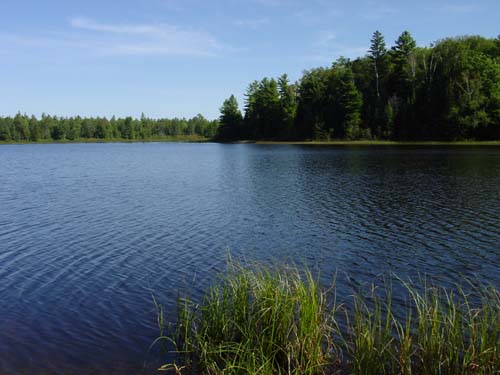1952 Flight to Oblivion
Sources: "The Great Lakes Triangle" by Jay Gourley, "Haunted Lakes" by Frederick Stonehouse, Internet Source "UFO Review"
 Little Beaver Lake by south shore of Lake Superior
Little Beaver Lake by south shore of Lake SuperiorOn November 28, 1952, a year before the Kinross Incident, a civilian twin engined Beech 35, registration CF_FUV, flown by pilot F. Jake mysteriously disappeared over Lake Superior. Besides the location, there were other similarities between the two incidents.
The pilot and three passengers had left Edmonton, Alberta bound for a Grey Cup game at Toronto on a cross country trip. After refueling at Houghton Municipal Airport on Michigan's Keeweenaw Peninsula, they headed east across the open waters of Lake Superior. They were watched closely by US radar stations who were monitoring air traffic on the US/Canadian border region.
"About 40 miles northwest of Grand Marais, Michigan, and 35 miles northeast of Marquette, Michigan, CF-FUV, F. Jake and all three passengers flew away. They vanished silently from the radar screen. The position was noted by the radar controller."
There was no radio broadcast of any distress from the pilot and no trace of the planes wreckage or the bodies of the pilot or passengers was found in the following search.
In 2004 I made a trip to Ottawa to do some research at the Canadian Archives. In my search of the Canadian Air Force Search and Rescue files, I found much material that was intriguing as I reviewed several files from the years 1952 through 1954.
I was already somewhat acquainted with the account of the mysterious disappearance of the Beech 35 in 1952 and I was quite surprised to find some telexes which related back to this mystery. While the telexes revealed that some remnants of the crashed plane were found in 1954, the circumstances seemed to add to the mystery, rather than clearing it.
What was revealed in these telexes was that on April 2, 1953, the RCAF received a report from the US Coast Guard that a fisherman from Selma, Michigan had found "articles of cloting, a personal kit, and aircraft parts" in north Beaver Lake, located twenty miles west of Grand Marais, Michigan.
For me, the location of the find was quite a coincidence, as I have a very strange memory which may relate in some way back to the Kinross Incident from a hill overlooking Beaver Lake. (refer to Grand Marais Incident)
The flying jacket that was found, marked with "Beacon Canada" and the personal gear were confirmed to be the possessions of Mr. Edgar, a passenger of the Beech Bonanza which had disappeared four months earlier over Lake Superior. The aircraft parts were also confirmed as belonging to the Beechcraft Bonanza.
It can be assumed that the Coast Guard or someone conducted a search of the area to locate other parts of the wreckage, but the telex reveals that no other parts of the wreckage were found. How did the jacket and parts get to Beaver Lake?
It should be noted that Beaver Lake is a very small lake, located several hundred feet from the south shore of Lake Superior in present day Pictured Rocks National Lakeshore. The terrain between Beaver Lake amd Lake Superior is a sandy, forest covered stretch. Logically, the find would suggest that the wreckage should be located in Beaver Lake or on its shores unless the aircraft broke up high in the air and the main part of the wreckage fell some distance away in Lake Superior. However, if this were the case, it would seem logical that parts of the wreckage would wash up on the south shore of Lake Superior in the region of Beaver Lake, which is some distance south of the last reported postion of the aircraft observed on radar.